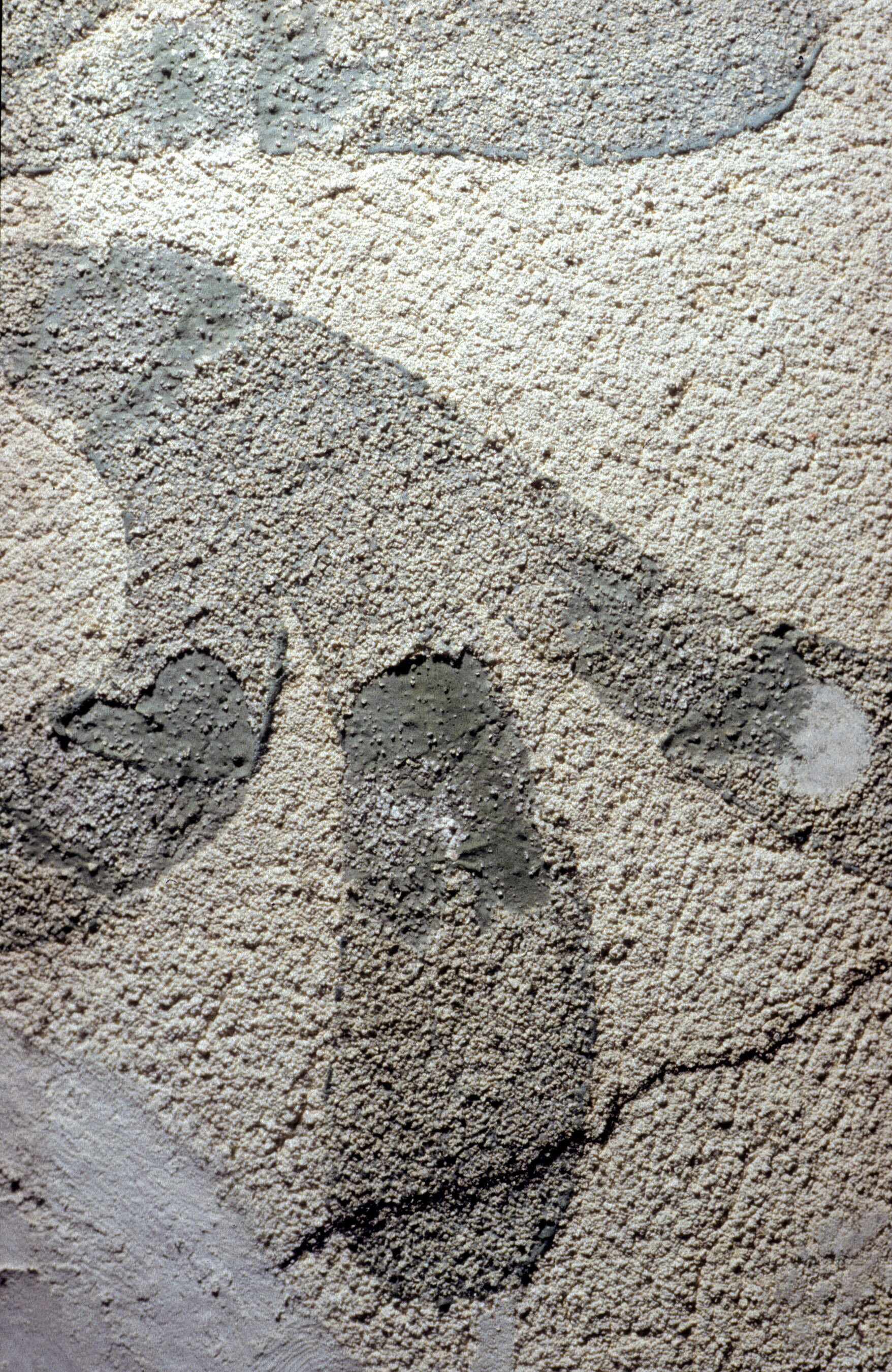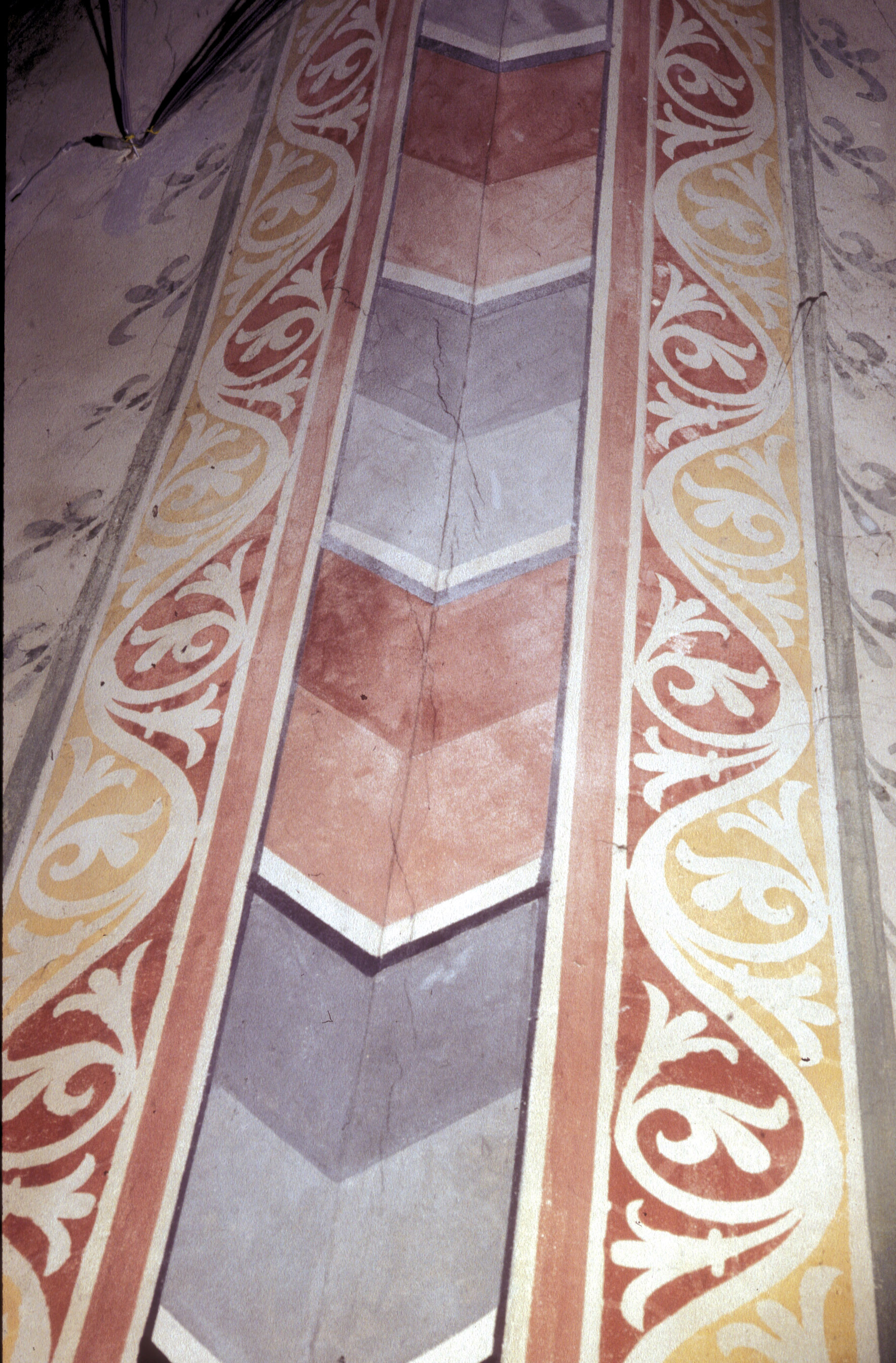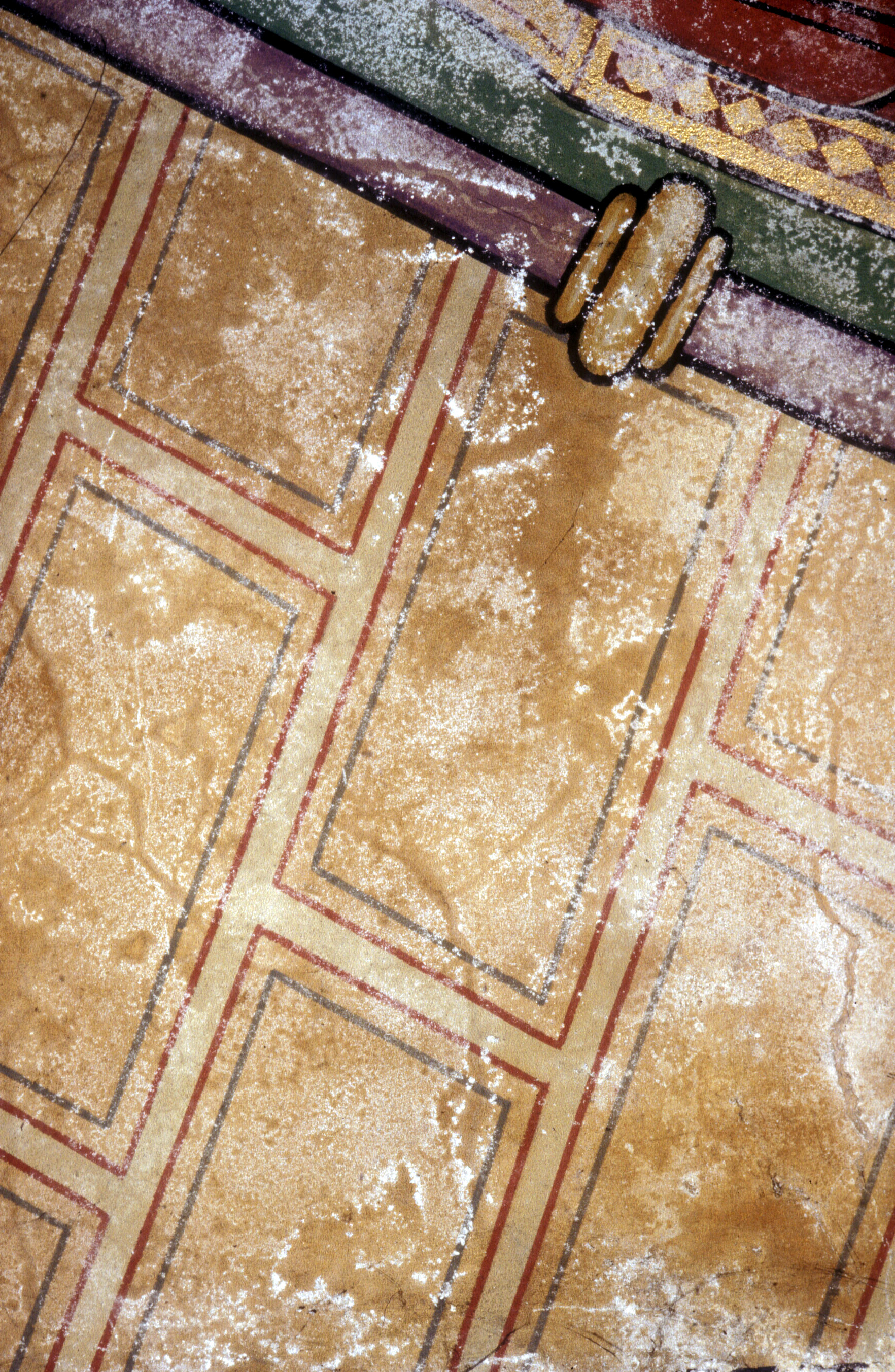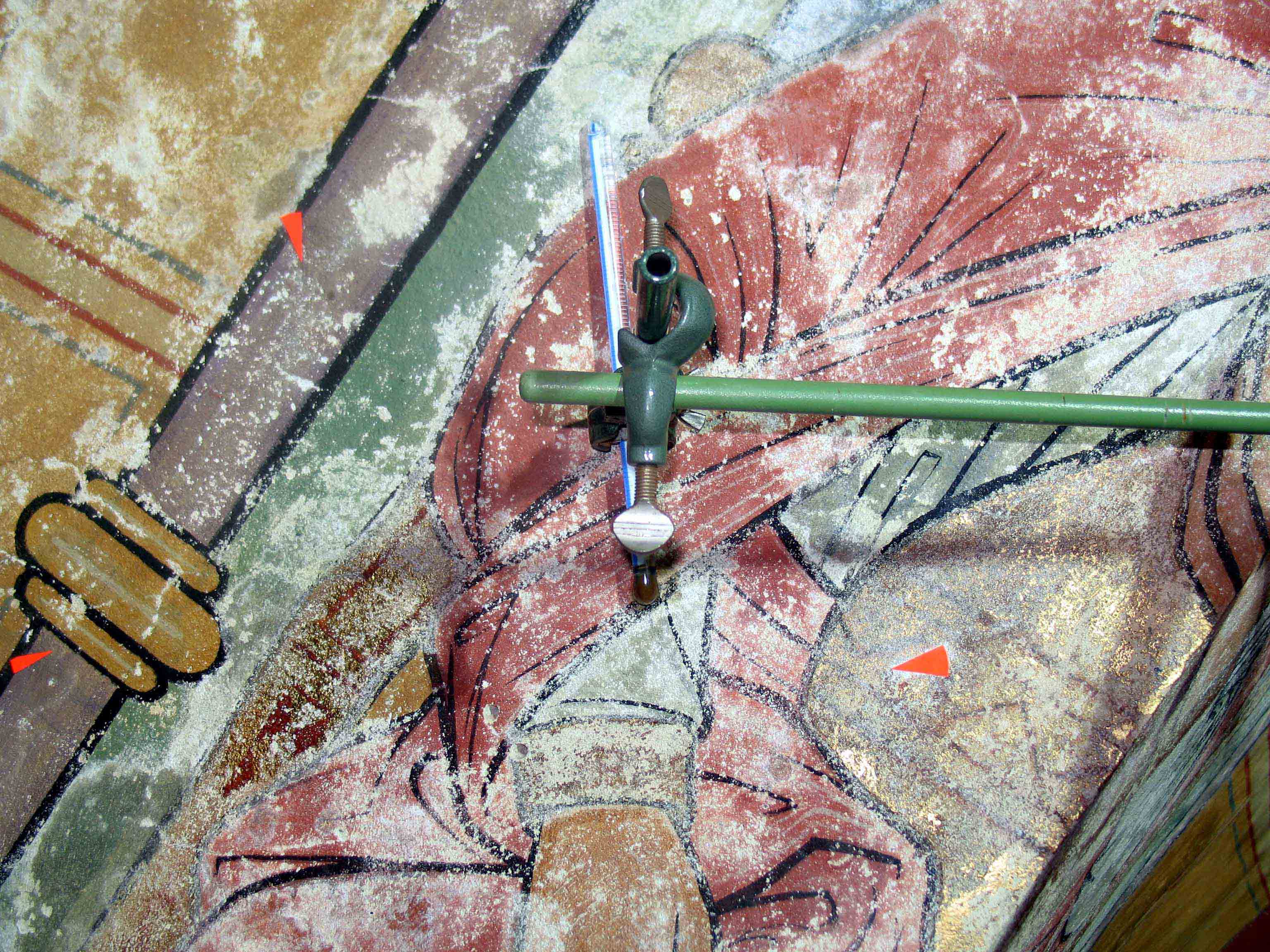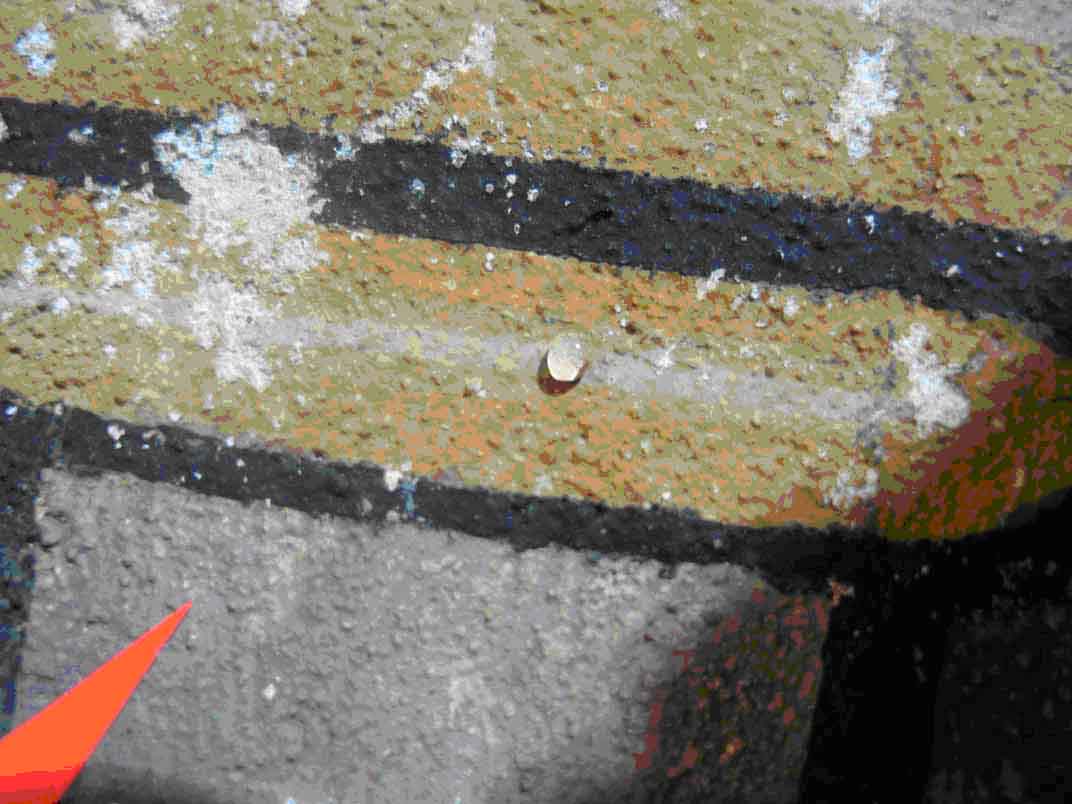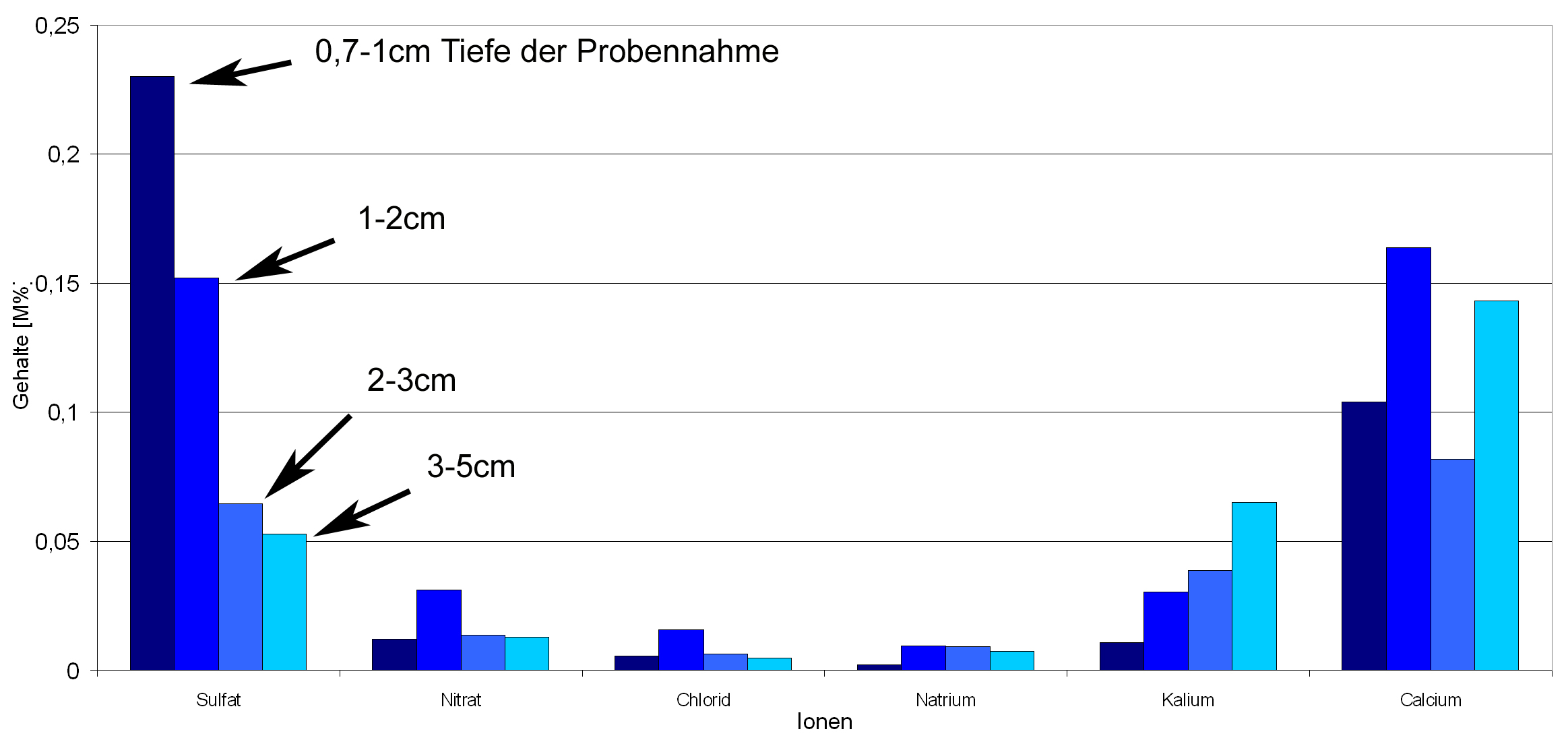The Wall paintings at the Kaiserdom in Königslutter (Imperial Cathedral at Königslutter): Difference between revisions
No edit summary |
|||
| Line 106: | Line 106: | ||
==Simulation calculation of the sequence of crystallization== | ==Simulation calculation of the sequence of crystallization== | ||
Using the software RUNSALT/ECOS (<bib id="Price: | Using the software RUNSALT/ECOS (<bib id="Price:2000"/>) starting with the quantitative results of our samples, the possible sequences of crystallisation were calculated depending on relative humidity and air temperature. | ||
After the salt reducing tests two samples were taken at the “NW-Fluss”. Both show a calculated start of salt crystallization at about 80% RH with KNO<sub>3</sub> as the most important salt besides the omnipresent gypsum. | After the salt reducing tests two samples were taken at the “NW-Fluss”. Both show a calculated start of salt crystallization at about 80% RH with KNO<sub>3</sub> as the most important salt besides the omnipresent gypsum. | ||
The test areas at the S-transept show after the desalting a calculated salt system starting crystallisation just below 40% RH, which means that in addition to gypsum no other salt will crystallize in the actual climate of the cathedral. | The test areas at the S-transept show after the desalting a calculated salt system starting crystallisation just below 40% RH, which means that in addition to gypsum no other salt will crystallize in the actual climate of the cathedral. | ||
Revision as of 13:44, 20 August 2012
Author: Hans-Jürgen Schwarz, Erwin Stadlbauer, Rolf Niemeyer
English version edited by Sandra Leithäuser
back to Case Studies
Abstract[edit]
This case study deals with salt damage on wall paintings of Königslutter Imperial Cathedral (German: Kaiserdom). Methods of investigation and analysis and measures for extracting salts from the wall paintings are described.
Introduction[edit]
The contamination of walls with salts and a salt solution is often one of the biggest difficulties concerning the conservation concept of wall paintings. The Imperial Cathedral at Königslutter (Northern Germany) is a good example for this problem.[Schwarz.etal:2008]Title: Diagnostic investigations to define the possibility and the effectiveness of desalination with the poultice-technique - a case study
Author: Hans-Jürgen Schwarz; Erwin Stadlbauer; Rolf Niemeyer
The 13th century wall paintings of the Imperial Cathedral at Königslutter were over-painted at the end of the 19th century. In the second half of the 20th century large amounts of cement suspension were injected into the walls to stabilize the structure of the building. This initiated the damaging process essentially by salt crystallization on the inner surfaces of the cathedrals walls. After repairs to the exterior of the cathedral were completed in 2006, the conservation of the interior, i.e. wall paintings, plasters etc. began. The analyses of surface samples and the drill-sampling showed a high salt content consisting of sulphate and calcium ions, nitrates (mostly in combination with potassium, but also with calcium) and rarely chloride and sodium. Salt efflorescence often consisted of gypsum, partially with calcite as a sinter crust. Fluffy efflorescence consist of niter. Only in some cases the total amount of salt decreased with the depth of sampling.
In order to extract the salts in the wall painting and in the plaster, the poultice method was chosen. Before applying this method, the surfaces have to comply with the requirements for a successful application, e.g. the moisture transport characteristics. The results showed clearly that the first plaster layer, which was slightly hydrophobic in some areas, transported moisture very slowly. Despite the low moisture transport rates the poultice method was tested, because salt action was considered to be more damaging than the treatment. The application tests showed that it was only possible to extract a small amount of salt.
This case study focused on diagnostic investigations in order to characterize selected areas and estimate the effectiveness of the desalination with the poultice-technique. For this purpose it was necessary to determine the exact content oft the salts, the distribution of the different ions and the salt minerals which could form in dependence of the climatic parameters. Of equal importance were the hygric properties of the materials regarding the capillary transport of moisture, as well as the diffusion of water vapour [Niemeyer.etal:1996]Title: Die Wasserdampfdurchlässigkeit der Wandmalereioberflächen im Innenraum der Stiftskirche Königslutter
Author: Niemeyer, R.; Stadlbauer, E. .
.
Case History[edit]
The wall paintings of Königslutter Imperial Cathedral date back to the 13th century. Like many other wall paintings of that time they were altered and underwent changing conditions regarding physical, chemical and biological influences. Presumably, a whitewash covered them from the 16th until the end of the 19th century. In the years 1886-1894 the wall paintings were uncovered and restored by Essenwein and Quensen ([Königfeld:1996]The entry doesn't exist yet. ; [Grote.etal:2001]Title: Wandmalereien in Niedersachsen, Bremen und im Gronigerland
Author: Grote, R.; van der Ploeg, K. ). Reference was paid to the original medieval surface, but it was in fact nearly completely over painted.
). Reference was paid to the original medieval surface, but it was in fact nearly completely over painted.
- Salt damage of the wall paintings in Königslutter Imperial Cathedral
In 1974 large amounts of cement suspensions were injected into the walls to stabilize the building. The wall paintings were previously treated with an acrylic resin in order to protect the surface. However, while the structural consolidation succeeded, the protection of the wall paintings failed. Comprehensive diagnostic investigations was started around 1990 and it was evident that, as a consequence of the injected suspension, the masonry was intensively penetrated with moisture. The damaging process was essentially caused by the mobilisation and the crystallisation of salts ([Rösch:1996]The entry doesn't exist yet.).
On the basis of these results, a long-term concept for the preservation of the cathedral, including the conservation and restoration of the wall paintings, was developed by an interdisciplinary group of experts. As the first step, the urgent repairs to the exterior of the cathedral were completed in 2006. This was combined with the stabilisation of the climate in the interior of the building, particularly with respect to the relative humidity. Furthermore, the effectiveness of these measures was controlled from 2003 onwards, by monitoring the representative areas of the surface ([Behrens.etal:2005]Title: Wandmalerei-Referenzflächen-Monitoring am Beispiel der Stiftskirche Königslutter – Methoden und Erkenntnisse für die praktische Denkmalpflege
Author: Behrens, Elke; Berling, Helmut; Hornschuch, A.; Niemeyer, Rolf; Recker, Bernhard; Schwarz, Hans-Jürgen; Stadlbauer, Erwin ). The photographic monitoring was combined with a variety of non-destructive diagnostic investigations and with a limited number of samples for chemical analysis.
). The photographic monitoring was combined with a variety of non-destructive diagnostic investigations and with a limited number of samples for chemical analysis.
Measures[edit]
Methods[edit]
Quantitative chemical analyses
The total amount of salt can be estimated by measuring the conductivity of the aqueous extract of the samples. The quantitative determination of Na+ , K+, Ca2+, Mg2+, NO3 -, Cl- and SO4 2- was carried out by photometry and a Na - selective electrode.
X-Ray Diffraction Analyses (XRD) of mineral phases
By X-ray diffraction (XRD) the mineral phases were analysed on powder samples by a Bruker D4 Endeavor.
Salt screening with the Polarising Microscope (PM)
With the polarising microscope (Zeiss Axioplan 50) the aqueous extracts of a sample after drying on a microscope slide were analysed for salt phases and the hygroscopic behaviour of the salt system.
Water uptake with the method of Mirowski
The method after Mirowski was used to measure the capillary uptake of water on surfaces, i.e. the hydrophobic / hydrophilic properties. The water is introduced to the surface by a glass tube with a sponge on the end facing the wall. The greater the suction value of a surface the more water is taken from the cylinder. Surface points, which are observed to be hydrophobic with the droplet method, are not further studied with the Mirowski method.
Determination of the absorption of water with the droplet method
With the droplet method around 10 μl of water were placed upon the surface to be tested. The time until total absorption of the water droplet is a quantitative measure of the water absorption velocity, i.e. the hydrophobic / hydrophilic properties.
Samples, Measuring points[edit]
Two model areas were chosen for testing the poultice method. Before and after applying the poultices, samples of up to 10 cm in depth were taken with a spiral drill (1cm Ø) and analysed for salt ions. Before the application of the poultices in the model areas, 22 samples were analysed quantitatively for their ions and 18 samples, which were salt efflorescences and other surface samples from different locations, were analysed for the salt phases and the hygroscopic behaviour of the salt system. After the application of the poultices 12 samples from these areas were taken to estimate the effectiveness of the desalination process. To characterise the moisture transport on the surfaces on the points in each model area,measurements with the Mirowski-tube were carried out. The droplet method was applied at more than 40 places for each model area.
Poultices[edit]
Three recipes were used:
- Recipe 1 "wet": 20g poultice mixture 1:1 (Arbocel® 200 und Arbocel® 1000) and 168 ml deionised water.
- Recipe 2 "let dry I: 20g poultice mixture 1:1 (Arbocel® 200 und Arbocel® 1000) and 129 ml deionised water with an intermediate layer of Japanese paper.
- Recipe 3 "let dry II": 20g poultice mixture 1:1 (Arbocel® 200 und Arbocel® 1000) and 127 ml deionised water without an intermediate layer of Japanese paper.
Results[edit]
The results of the analyses of salts and salt forming ions were: In all sampled areas on or near the surfaces, the amount of salt found was very high. The salt composition consisted mostly of sulphate and calcium (fig. 4), in some areas nitrates (with potassium but also calcium as the counter ion). Only in very few cases sodium and chlorides were found. The white powdery efflorescences are made of gypsum and sometimes of calcite too (sinter crust). The fluffy whiskers consist of niter (KNO3).
Water uptake by the surfaces of the wall paintings[edit]
The uptake of water by capillary sorption was low to very low. With the Mirowsky method values of about 0,8 ml/h were measured. The greatest water absorption occurred on surface defects and gilded areas, but only sometimes the 10μl droplet was taken up in a few seconds. Mostly, it took 1 –10 minutes. In some places e.g. the green regions in the “SO Fluss” the droplets were visible even after more than 40 minutes (hydrophobic surface).
Studies with the droplet method were also carried out on samples of the plaster layers, which are divided in a first and a second layer. The first layer always showed very low water absorption, whereas the second plaster layer always immediately incorporated the droplet into the structure. The first layer showed the effect of low water suction on both sides of a sample.
Testing the salt reducing method[edit]
The salt reducing methods were applied and verified in two areas of the cathedral vault, which suffered from damage due to different salt systems. Three recipes were tested using a step by step application of the cellulose poultice. The first poultice was applied for a very short time (2-3 minutes) followed by a second poultice layer, which was left to dry out and take up any dissolved salts from below. As a first result only the poultices without a protective layer of Japanese paper did not fall off and dried out in situ.
Analyses of salts in the poultices[edit]
Samples for analysis were chosen to assess the results of the measures in the model areas:
- the poultices after drying,
- a neutral poultice (with just the starting materials) as well as again
- drill dust samples from the areas which were sampled before and which now represent the salt content after the application of the poultices,
Overall, only 5% of the salts could be extracted by using the applied methods. The poultices did not reach depths of more than 1 cm.
Simulation calculation of the sequence of crystallization[edit]
Using the software RUNSALT/ECOS ([Price:2000]Title: An Expert Chemical Model for Determining the Environmental Conditions Needed to Prevent Salt Damage in Porous Materials, European Commission Research Report No 11, (Protection and Conservation of European Cultural Heritage) ) starting with the quantitative results of our samples, the possible sequences of crystallisation were calculated depending on relative humidity and air temperature.
After the salt reducing tests two samples were taken at the “NW-Fluss”. Both show a calculated start of salt crystallization at about 80% RH with KNO3 as the most important salt besides the omnipresent gypsum.
The test areas at the S-transept show after the desalting a calculated salt system starting crystallisation just below 40% RH, which means that in addition to gypsum no other salt will crystallize in the actual climate of the cathedral.
) starting with the quantitative results of our samples, the possible sequences of crystallisation were calculated depending on relative humidity and air temperature.
After the salt reducing tests two samples were taken at the “NW-Fluss”. Both show a calculated start of salt crystallization at about 80% RH with KNO3 as the most important salt besides the omnipresent gypsum.
The test areas at the S-transept show after the desalting a calculated salt system starting crystallisation just below 40% RH, which means that in addition to gypsum no other salt will crystallize in the actual climate of the cathedral.
Conclusions[edit]
The results of investigations of surface samples and drill-sampling up to 10cm depth, confirmed a high salt content consisting of sulphate and calcium ions, considerable amounts of nitrate (mostly with potassium but also with calcium) and rarely chloride and sodium ions. Much of the salt efflorescence was produced by gypsum, partially with calcite as a kind of sinter crust. The fluffy efflorescence consisted of niter. The total amount of salt, in some cases only, decreased with the depth of sampling. Salt efflorescence was easily removed using dry methods. The poultice method was chosen for extracting the salts and salt forming ions from inside the wall painting and the plaster. Before applying this method the surfaces have to comply with the requirements for a successful application, especially the moisture transport characteristics. The results show clearly that the first plaster layer transports moisture very slowly, which means that it is slightly hydrophobic. These were not a good conditions for applying the poultice method. The result of the application tests show that only a small amount of salts could be extracted. Altogether less than 5% of the total amount of salt could be removed, which meant that the method as tested is not promising to be very successful.
Because of the low efficiency of the tested method, it should not be applied in this way. An substantial efficiency in the depth is not given, because of the low capillary water suction characteristics of the first plaster layer in many parts of the surface.
Alongside the dry removal of the visible salts, the recommendation for desalination- as the result of our investigations- is that the salts near the surface should be removed by application of one thin poultice in combination with a controlled climate. By application of a single, not excessively wet poultice, a great deal of these salts can be removed.
After drying, the near surface salts can be taken off. Although not a great amount of salts will be removed, the surface of the wall paintings will be better prepared for all further applications, e.g. retouching. Moreover any salt damage will probably be delayed for some time.
Once more, the investigations have clearly shown that before salt removal poultices are used, the water transport rate and hydrophobic/hydrophilic properties of the underlying plasters should be known.
Literature[edit]
| [Behrens.etal:2005] | Behrens, Elke; Berling, Helmut; Hornschuch, A.; Niemeyer, Rolf; Recker, Bernhard; Schwarz, Hans-Jürgen; Stadlbauer, Erwin (2005): Wandmalerei-Referenzflächen-Monitoring am Beispiel der Stiftskirche Königslutter – Methoden und Erkenntnisse für die praktische Denkmalpflege. In: Berichte zur Denkmalpflege in Niedersachsen, (1), 9-12 |  |
| [Grote.etal:2001] | Grote, R.; van der Ploeg, K. (2001): Wandmalereien in Niedersachsen, Bremen und im Gronigerland, Deutscher Kunstverlag |  |
| [Koenigfeld:1996] | Königfeld, P. (1996): Die Raumausmalung. In: Braunschweigischer Kloster- und Studienfond, Institut für Denkmalpflege (eds.): Der Kaiserdom in Königslutter. Ein Kulturdenkmal auf dem Prüfstand, Niedersächsisches Landesverwaltungsamt, Hannover, 10-13. |  |
| [Niemeyer.etal:1996] | Niemeyer, R.; Stadlbauer, E. (1996): Die Wasserdampfdurchlässigkeit der Wandmalereioberflächen im Innenraum der Stiftskirche Königslutter. In: raunschweigischer Kloster- und Studienfond, Institut für Denkmalpflege (eds.): Der Kaiserdom in Königslutter. Ein Kulturdenkmal auf dem Prüfstand, Niedersächsisches Landesverwaltungsamt, Hannover, 54-58. |  |
| [Price:2000] | Price, Clifford A. (eds.) (2000): An Expert Chemical Model for Determining the Environmental Conditions Needed to Prevent Salt Damage in Porous Materials, European Commission Research Report No 11, (Protection and Conservation of European Cultural Heritage), Archetype Publications Ltd, London |  |
| [Roesch:1996] | Rösch, Heinrich (1996): Salz- und Fuchtebelastung. In: Grote, Rolf Jürgen; Königfeld, Peter (eds.): Der Kaiserdom in Königslutter. Ein Kulturdenkmal auf dem Prüfstand, Braunschweigischer Kloster- und Studienfond, Institut für Denkmalpflege, Hannover, 59-63. |  |
| [Schwarz.etal:2008] | Hans-Jürgen Schwarz; Erwin Stadlbauer; Rolf Niemeyer (2008): Diagnostic investigations to define the possibility and the effectiveness of desalination with the poultice-technique - a case study. In: Ottosen, Lisbeth M.; Rörig-Dalgaard, Inge; Larsen , Poul Klenz; Brajer, Isabelle; Bøllingtoft, Peder; Marciniak, Mette; Svane, Maja (eds.): Salt Weathering on Buildings and Stone Sculptures, Technical University of Denmark, Lyngby, Denmark, 237-248. |   |
